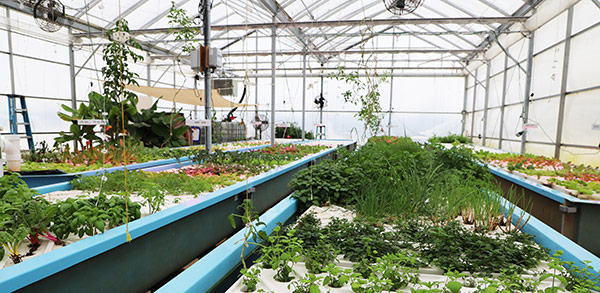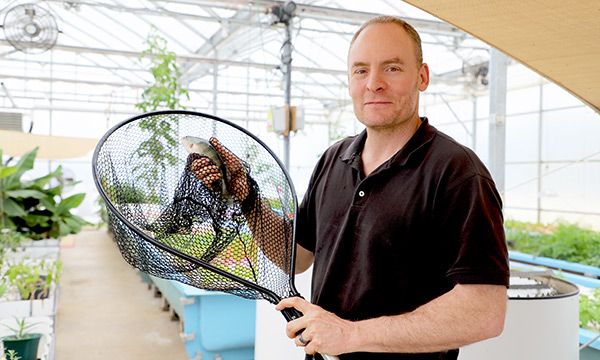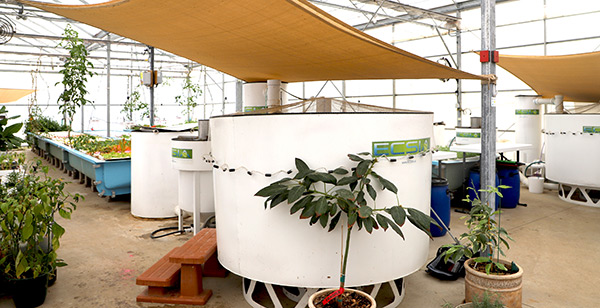Sustainable Aquaponics Farm Uses YSI Instruments to Reduce Crop Failure
(Updated September 2021)
Oasis Aqua Farm is a family-owned and operated sustainable farm located in Beavercreek, Ohio. (Oasis Aqua Farm, unfortunately, suffered a direct hit from a tornado that devastated their operations. However, their past instrumentation use can still provide insight). They produce fruits, vegetables, and fish year-round in a 2500-square-foot aquaponics greenhouse. Aquaponics combines traditional aquaculture with hydroponics. No soil is used and the fish and plants thrive in a symbiotic relationship. Fish provide nutrients for the plants and the plants naturally purify the water for fish. Creating and maintaining this closed ecosystem allows Oasis to grow highly nutritious vegetables along with a lean source of protein in an accelerated time frame.

This unique growing system boasts many benefits. For example, aquaponics provides a natural ecosystem that is pesticide and chemical free. Oasis Aqua Farm uses only non-GMO seeds and organic products with no artificial fertilizers. Instead of using additional fertilizers, nutrients derived from fish waste are processed on site into organic plant fertilizer. Their greenhouse system produces higher quality food with less impact than traditional farming practices. Additionally, Oasis is eco-friendly to the surrounding environment by operating as a zero waste system and conserving water. In fact, the Oasis aquaponics facility uses only 5% of the water used by traditional farming practices.

Using only 5% of the water a traditional farm uses, Oasis aquaponics farm produces fruits and vegetables (e.g. mixed lettuces, herbs, tomatoes), and raises yellow perch and bluegill shown here by owner, Kimball Osborne.
Oasis is currently raising yellow perch and bluegill and will be adding Australian red claw crayfish (fresh water lobster) to their system soon. The crayfish will eat the dead roots of the plants to help rejuvenate the plant growing process.
Because the farm is a 7,000 gallon zero-discharge aquaponics system, water quality is paramount. Oasis monitors key parameters to maintain optimal water quality conditions for both the fish and the plants. Wide fluctuations in pH, temperature, ammonia, nitrites, and dissolved oxygen can prove fatal to the fish. The pH and temperature of the water are also vital to nutrient availability for the plants. pH levels outside of the optimal range can block nutrient uptake and lead to deficiencies in the produce. The facility also monitors nitrates, calcium, magnesium, and potassium. If not properly balanced in aquaponics, these elements will block each other and lead to nutrient deficiencies even if the nutrients are present.
Prior to using proper monitoring equipment, the farm relied on visible signs of crop deficiency since the instruments they had been using provided inaccurate measurements. The issue with the visual method was that sometimes the nutrients were present but not in proper balance. This resulted in periods of selective crop loss and a need for more accurate, reliable equipment.
YSI provided an effective solution with the 9300 photometer and the 5200A monitor. The YSI instruments are able to accurately measure all of the parameters that are essential to the health of the aquaponics system. For the first time in 7 months, Oasis was able to identify the nutrients that were wreaking havoc on their crop and fix the imbalance. They finally have the data required to balance the water chemistry and ensure success. Their crop failures have been resolved and they have increased profits for their business.
The farm plans on utilizing all capabilities of the 5200A for real time monitoring, including the alarm functions, to protect their investment in the event of power failure, oxygenation failure or temperature swings.
Below is a list of the currently monitored parameters that YSI instruments provide to Oasis.
pH affects both the fish and the plants. There is a pH sweet spot in aquaponics where neither the plants nor the fish prefer to be, but both will tolerate and thrive. Plants in general tend to like a more acidic pH while fish prefer a more basic pH. The ideal pH level for Oasis is between 5.8 and 6.5. While they were able to measure pH prior to using YSI’s instruments, their previous system gave them inaccurate and unreliable measurements. The prior method of using test tubes and color coding often left them unsure of the actual pH of the water. The pH also affects nutrient availability. If the pH is out of the ideal range, plants will show nutrient deficiency even if nutrients are present; therefore, it is crucial to be able to accurately monitor and adjust the pH.
Temperature also affects both the fish and produce. Too high of a temperature will cause some plants (leafy greens) to bolt and will also provide an ideal environment for bad bacteria to develop. Continual monitoring of the temperature allows Oasis to use shade cloths, fans and other methods to regulate the temperature.

Shaded fish tanks inside the facility.
Ammonia is a byproduct of fish respiration and excretion. Too much ammonia will prove fatal to the fish. In a properly functioning aquaponics system, ammonia should be almost non-existent as the bacteria break it down into nitrites and nitrates. By monitoring ammonia, Oasis is able to take a proactive approach by identifying issues that would cause a massive fish kill and detecting the source of excess ammonia.
Nitrites are what ammonia is broken down into first. Excessive nitrites demonstrate an issue in the system. High nitrites can also kill the fish. In a properly functioning system, nitrites should be low since the bacteria balance will break them down into nitrates.
Nitrates are another measurement of nitrogen in the system. If the nitrates are too low, then Oasis needs to supplement with fish fertilizer, add more fish or adjust the feed ratios.
Dissolved oxygen - lack of dissolved oxygen will kill the fish faster than anything. Oasis needs to monitor dissolved oxygen to decipher whether or not the oxygenation system has blocked inlets or if the temperature is too high. While dissolved oxygen is important to the fish, it is also crucial to the plants. Because the plants are grown in water, the water must be oxygenated or the plants roots will suffer and die.
Calcium is also crucial to plant growth. Calcium is an essential part of the plants’ cell structure and assists in transport and retention of other essential elements as well as the strength of the plant.
Magnesium is part of the chlorophyll of the plant and is essential for photosynthesis. Oasis had been unable to find a way to test magnesium until they used YSI’s equipment.
Potassium helps in the building of protein, photosynthesis, disease defense and root growth. Before using YSI, Oasis had a difficult time finding instruments that would provide accurate and dependable measurements for potassium. They had previously tested other equipment but tests were unreliable.
Monitoring the parameters above is vital to maintaining water quality in any aquaponics facility. YSI instruments provide peace of mind with accurate real-time measurements and the data needed for optimal process control.

Additional Blog Posts of Interest
How Aquaculture Facilities Benefit from Automation
Sustainable Land-Based Atlantic Salmon Production
Aquaculture Monitoring & Control Webinar (Recording)
Automation Leads Organic Shrimp Producer to the Forefront